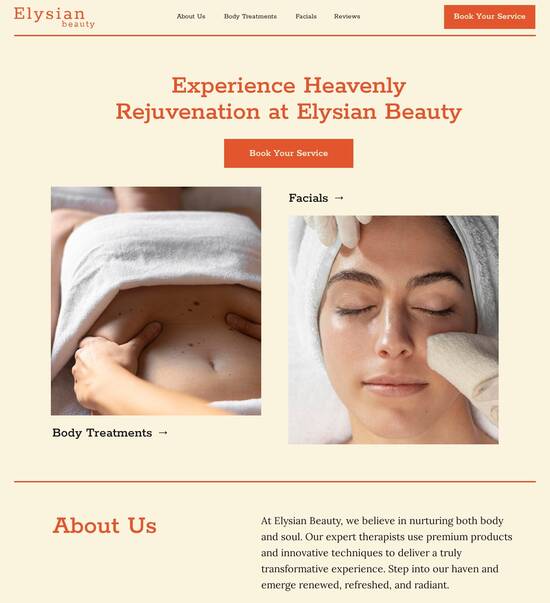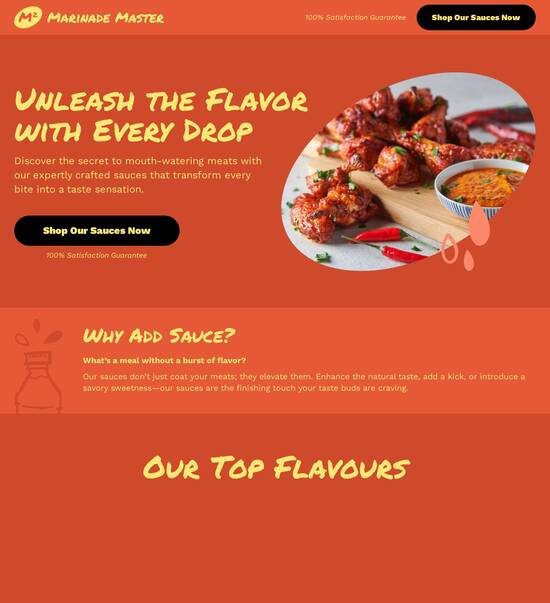
Landing page template with interactive report form
Explore Similar TemplatesAbout template
Use landing page templates with interactive report form and make your communications easy and transparent. Try our solution today.
Recommended templates

Easy to build without coding
With the intuitive drag-and-drop builder, anyone on your team can create high-converting pages without any knowledge of code or design. Make enhancements to your landing page with custom widgets using Javascript, HTML/CSS, or third-party scripts.

Multiple layouts for any industry and goal
Select from 500+ landing page layouts built to boost conversions across industry-specific scenarios. Customize them by adjusting fonts, adding images, and generating on-brand content with the AI assistant. Quickly scale with Instablocks® and Global Blocks that you can save, reuse, and update globally.

Loads fast and looks polished on any device
Every template is responsive, which means they present professionally on any device and load blazingly fast with our Thor Render Engine. You can also power them up with Google AMP technology to deliver an unparalleled mobile experience and drive higher conversions.

Robust analytics & experimentation
Get real-time updates and reporting across all your devices, showing the number of visitors, conversions, cost-per-visitor, and cost-per-lead. Launch AI-powered experiments, run A/B tests, and use heatmaps to analyze user behavior, then optimize your landing page to maximize conversions.







Easy to build without coding
With the intuitive drag-and-drop builder, anyone on your team can create high-converting pages without any knowledge of code or design. Make enhancements to your landing page with custom widgets using Javascript, HTML/CSS, or third-party scripts.
Multiple layouts for any industry and goal
Select from 500+ landing page layouts built to boost conversions across industry-specific scenarios. Customize them by adjusting fonts, adding images, and generating on-brand content with the AI assistant. Quickly scale with Instablocks® and Global Blocks that you can save, reuse, and update globally.
Loads fast and looks polished on any device
Every template is responsive, which means they present professionally on any device and load blazingly fast with our Thor Render Engine.
Robust analytics & experimentation
Get real-time updates and reporting across all your devices, showing the number of visitors, conversions, cost-per-visitor, and cost-per-lead. Launch AI-powered experiments, run A/B tests, and use heatmaps to analyze user behavior, then optimize your landing page to maximize conversions.
All the features you need to build lead-generating landing pages
Explore more featuresLearn how to build top-performing landing pages for any goal
FAQs
Leading the way in building high-performing landing pages





An essential guide to optimizing landing page templates with an interactive report form
Creating high-converting landing pages is crucial for any digital marketing campaign. Instapage offers powerful templates that allow businesses to integrate interactive report forms seamlessly, enhancing user engagement and driving conversions. This guide will walk you through the steps needed to effectively utilize these templates for maximum impact.
Understanding the importance of landing page templates
Landing page templates are pre-built designs that enable marketers to create focused and compelling web pages aimed at specific goals. By using Instapage's customizable templates, businesses in various sectors, including tech, finance, and education, can maintain brand consistency while ensuring high performance. High-quality landing pages are essential for capturing leads and providing essential data to inform future marketing tactics.
- User engagement: Using interactive elements helps to keep visitors on the page longer, increasing the chances of conversion.
- Branding consistency: Templates ensure that the presentation of your brand remains uniform across digital platforms.
- Data collection: Interactive forms facilitate easy data gathering, offering quick insights into audience preferences.
Choosing the right landing page template for your needs
To maximize the effectiveness of your landing page, consider the following factors when selecting a template:
- Customization options: Ensure the template allows modifications to align with your brand’s aesthetics.
- Form integration: The ability to integrate interactive report forms is crucial for gathering user data, making it easier to analyze customer behavior.
- Responsive design: Given the diverse range of devices used by visitors, verify that templates are mobile-responsive to provide optimal viewing experiences.
Setting up your interactive report form
To set up your interactive report form effectively, follow these critical steps:
- Use intuitive builders: Leverage Instapage's drag-and-drop capabilities for effortless form placement and customization.
- Define your goals: Clearly outline what information you want to collect to tailor your form’s fields appropriately.
- Implement personalization: Use dynamic text replacement to customize form fields based on user data to create more targeted outreach opportunities.
In conclusion, utilizing Instapage's landing page templates with interactive report forms is a game-changer for enhancing engagement and improving conversion rates. By following the outlined steps, marketers can effectively drive quality leads and optimize their marketing strategies.
Start transforming your digital marketing campaigns today by leveraging Instapage's robust templates to streamline lead generation efforts. Explore the full potential of your online presence and watch your ROI soar!
People also ask about Landing page template with interactive report form
Understanding landing page templates with interactive report forms
The evolution of landing pages: Setting the stage for interactive engagement
Landing pages have undergone significant transformations since their inception in the early days of digital marketing. Initially, these pages served as simple online brochures, mainly designed to present a single product or service. However, as competition grew and customer expectations shifted, marketers had to innovate. Landing pages evolved from static, text-heavy formats to more engaging, interactive versions, designed to grab attention and facilitate conversions.
The shift from static to dynamic content reflects a broader change in how businesses interact with consumers. Now, customers expect personalized experiences and opportunities for engagement. This expectation has led to the integration of interactive features, particularly in landing pages and forms, which boost lead conversion rates significantly by inviting users to participate actively.
Defining the interactive report form: What sets it apart?
An interactive report form is a tool embedded on a landing page that encourages user involvement through features like sliders, checkboxes, and dropdown menus. Unlike traditional forms that simply ask users to input data, these forms create engaging experiences by allowing users to input data in a fun and simplified manner. They typically offer instant feedback or insights based on user choices, making data collection an engaging process.
Several industries have successfully implemented interactive report forms. For instance, in the tech sector, companies use these forms to collect detailed specifications from users seeking customized solutions. In education, interactive assessments allow students to self-evaluate and explore their interests. In all cases, the interactive report form enhances user experience by improving interaction, reducing friction, and ultimately driving conversions.
Unpacking the drag-and-drop builder: Simplifying the creation process
Creating landing pages with interactive report forms has never been easier, thanks to drag-and-drop builders. These tools empower marketers, regardless of their technical expertise, to design effective landing pages. The intuitive interface allows users to select elements like images, text boxes, and forms from a sidebar and place them on their page effortlessly, customizing layouts to their liking.
With a user-friendly design, non-tech-savvy users can focus on crafting beautiful, conversion-oriented pages rather than grappling with code. For those looking to explore this process, here’s a simple step-by-step guide: 1. Choose your template, 2. Drag elements from the sidebar, 3. Customize each element’s properties, 4. Preview your page, and 5. Publish seamlessly. This straightforward approach allows businesses to launch campaigns quickly and optimize based on real-time feedback.
Exploring the versatile template gallery: Finding the perfect fit
A well-structured template gallery is a crucial asset for marketers looking to create landing pages quickly. These galleries often feature a variety of templates tailored for specific industries, ranging from tech to financial services, each crafted to cater to unique audience needs. The diverse selection allows users to choose a template that resonates with their brand identity and objectives.
Customization options within these templates are extensive, allowing marketers to modify elements such as colors, fonts, and images. When selecting a template, consider the following tips: 1. Identify your target audience, 2. Align the template’s style with your branding, 3. Focus on industry-relevant design elements, and 4. Ensure it integrates well with interactive report forms. This strategic approach will enhance user experience and increase conversion potential.
Interactive report forms: Driving conversion through engagement
Interactive report forms effectively capture user data by engaging visitors in an enjoyable manner. By inviting users to explore options that reflect their preferences or requirements, businesses can gather informative insights for tailoring their offerings. This approach leads to a higher quality of leads since the users themselves are driving the conversation, thus making the form's completion rate significantly higher.
Various interactive elements enhance user experience, such as conditional logic branches—where the next question changes based on previous answers. Statistical evidence supports the positive impact of interactivity; studies have shown that interactive content can lead to a conversion rate increase of over 300% compared to traditional methods. This incentivizes businesses to prioritize interactive reports on their landing pages.
Harnessing the power of popups: An effective complement to landing pages
Popups play a vital role in enhancing user engagement on landing pages. When strategically timed and placed, these popups can encourage users to take action, providing additional information or enticements without detracting from the main content. For instance, a well-placed popup offering a discount or free resource as users show intent to leave can effectively reduce bounce rates and increase conversions.
Successful case studies demonstrate the significance of these popups. Companies have reported significant increases in sign-up rates and lead capture by deploying popups that target users displaying specific behaviors. To implement effective popup strategies, consider the following: 1. Set precise triggers for when the popup should appear, 2. Keep the message concise and enticing, and 3. Ensure the design aligns with the overall vibe of your landing page.
Canvas: The creative space for seamless design integration
The concept of a design canvas within landing page tools allows marketers to visualize their content and design effectively. This creative space not only aids in aligning visuals with textual content but also ensures that all elements work cohesively together. A well-organized canvas promotes a smoother design process, as users can drag, drop, and arrange components intuitively without losing sight of their objectives.
Additionally, using the canvas helps maintain brand consistency throughout the landing page. It enables marketers to strategically position their calls-to-action and interactive report forms, ensuring they're prominent yet integrated seamlessly with the entire page. To create an effective canvas design, prioritize the following: 1. Consistent styling across elements, 2. Logical organization of information, and 3. Visual hierarchy to guide user attention effectively.
Designing for different industries: Tailoring templates and forms
Each industry has unique landing page needs and preferences that influence design decisions. For example, tech companies might require bold colors and modern fonts, while educational institutions may prefer a clean, straightforward layout. Understanding these nuances is essential when designing a landing page with interactive report forms, ensuring the final product meets the expectations of target users.
Customizing templates based on industry type involves integrating relevant imagery, industry jargon, and user personas that speak directly to potential customers. For instance, a case study on an energy company demonstrated the effective use of interactive report forms that not only engaged users but also provided valuable insights into the company's offerings. The tailored approach ensured higher lead capture and improved conversion rates.
Optimizing for conversion: Best practices and innovative techniques
Conversion rate optimization (CRO) is crucial for maximizing the effectiveness of landing pages. Fundamental principles include ensuring your page has a clear goal, leveraging strong value propositions, and maintaining consistent and persuasive messaging throughout. Additionally, optimizing the layout and design to facilitate user experience is vital; minimizing distractions can lead to higher completion rates on interactive report forms.
A/B testing is another critical aspect of optimization. Experimenting with different elements—such as color schemes, button placements, or form lengths—allows marketers to identify which variations drive the best results. Insights into user experience (UX) should also inform design decisions. For instance, understanding the user's journey and pain points enables marketers to craft landing pages that genuinely address their audience's needs.
Real-time analytics: Measuring success through interactive tools
Real-time analytics have become essential for assessing landing page performance. Through the use of interactive tools, businesses can monitor user interactions, track completion rates for report forms, and gain insight into behavior patterns. This data is invaluable for determining which elements of the landing page are working and which require adjustments.
Features like detailed heatmaps and user session recordings provide insights into how users navigate their landing pages. By analyzing this data, marketers can refine their strategies and optimize landing pages for better performance. Understanding user behavior through interactive forms not only aids in short-term adjustments but also helps inform long-term marketing strategies.
Future trends in landing page innovation
Emerging trends in landing page design suggest a future increasingly driven by interactivity and user engagement. As technology continues to advance, we will likely see more immersive experiences that leverage augmented and virtual reality. These innovations could transform traditional forms and landing page templates into spaces that allow for real-time interaction and feedback.
Artificial intelligence (AI) is also set to play a significant role. AI can help marketers understand user preferences, personalize content dynamically, and automate testing processes. Exploring emerging technologies will help businesses stay ahead of competitors and create landing pages that truly resonate with audiences.
Best of both worlds: Combining forms and landing pages for maximum impact
Integrating interactive report forms within landing pages creates a powerful synergy that drives significant impact. By enhancing the landing page experience with interactive elements, businesses can prompt users to engage more deeply while collecting valuable data. This approach not only improves conversion rates but also builds a more comprehensive understanding of customer needs.
To effectively integrate report forms with your landing page design, consider strategies like aligning queries directly with user interests based on previous interactions, using open-ended questions to gather qualitative feedback, and providing instant insights to incentivize completion. Practical examples from successful campaigns illustrate how this integrated approach fosters user trust and leads to greater concessions.
Customization and personalization: Making connections count
Enhancing user experience through tailored content and designs is crucial for maximizing engagement. Customization options within interactive report forms allow businesses to cater directly to user preferences, thereby fostering a connection that can lead to conversions. This means offering options that reflect user interests, providing targeted information, or adapting formats based on user behavior.
Innovative ways to personalize interactive report forms include utilizing dynamic content that changes based on user input and segmenting audiences to deliver more relevant queries. Successful personalization strategies are supported by case studies that demonstrate the positive impacts on engagement and conversion rates. Understanding user demographics and interests ultimately leads to more effective landing pages.
Case studies: Success stories in landing page optimization
Notable brands achieving success with interactive report forms provide valuable insights for aspiring marketers. For instance, a well-known SaaS provider implemented an interactive report form to guide potential clients through a tailored selection process, leading to a marked increase in qualified leads. Their strategic positioning of the form and clear calls to action led to remarkable conversion rates.
Key takeaways from these examples illustrate the importance of cohesive design, user understanding, and strategic placement of interactive elements. Brands that prioritized personalization and engaging experiences successfully built customer loyalty and improved their overall marketing performance. Aspiring marketers should analyze these successful campaigns to identify strategies applicable to their own endeavors.
Navigating common pitfalls: What to avoid when designing landing pages
Designing landing pages can be a complex endeavor, and many marketers often fall into common traps. These include overloading pages with too much information, poor mobile responsiveness, and failing to match user expectations with the content presented. Such mistakes can lead to high bounce rates and decreased conversions, negating the effort put into crafting engaging forms.
Recognizing and rectifying ineffective practices is essential for successful landing page design. Employing tools such as usability testing and feedback gathering can highlight areas needing improvement. Furthermore, leveraging resources like webinars or content from experienced marketers can streamline the design process and enhance overall performance.
Future-proofing your landing pages: Adapting to industry changes
In a fast-evolving digital landscape, continual adaptation is vital for businesses aiming to maintain relevance. Staying attuned to industry trends, customer preferences, and emerging technologies will empower marketers to future-proof their landing pages. This proactive approach not only positions brands favorably in a competitive market but also enhances user engagement.
Strategies for staying ahead include subscribing to industry updates, participating in professional networks, and utilizing analytics tools to track shifting consumer behaviors. Such efforts will position companies to recognize opportunities for innovation and remain responsive to their audience's evolving needs.
Ready to skyrocket conversions?
Supercharge your ad campaigns with high-performing landing pages
Get started














